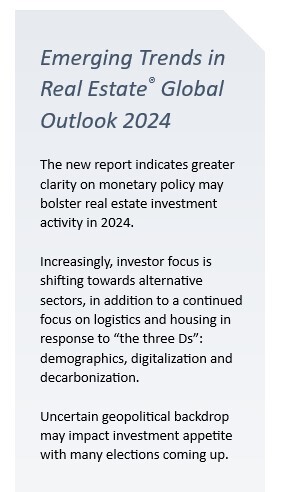Despite the monetary headwinds and continued economic uncertainty around the world, there is a strong belief that the global real estate industry is at a ‘pivot point’, with improving prospects ahead for renewed investment activity, according to the latest Emerging Trends in Real Estate® Global Outlook 2024 from PwC and the Urban Land Institute (ULI).
The report amalgamates three regional reports, which canvassed thousands of real estate leaders across Europe, the United States, and the Asia Pacific region, and is a key indicator of sentiment towards the global real estate investment and development outlook across the globe. The industry snapshot indicates that with moderating inflation and interest rates potentially peaking, and greater clarity on monetary policy, there is a degree of optimism that the market is gradually reconciling with an elevated “higher for longer” interest rate environment.
Many in the industry hope this will lead to an eventual market acceptance of an aligned pricing “middle-ground,” and in turn to recovery from one of the worst investment downturns across the globe in years, with transaction activity at its lowest since 2012, although any upswing is expected to be more pronounced in 2025 than this year. Nevertheless, this is tempered by a degree of caution, including because the jury is still out on the level of distress that may emerge in getting out of this crisis.
However, investment activity is also subject to varying degrees of uncertainty from geopolitical factors with elections planned in more than 60 countries, representing more than half the world’s population, and wars in Ukraine and Gaza continuing to impact sentiment, there is the potential to undermine the recent more stable monetary situation. Geopolitical uncertainty may have implications for global capital flows, with Asia Pacific markets seen as the likely beneficiaries in the short term. Moreover, the industry needs to refinance an immense debt burden of around $1.2 trillion in the United States alone, and the deployment of “rescue capital” will be a significant factor in the global narrative in 2024.
The report notes that while the industry has been in “wait-and-see’"mode for the last two years there is what is described as a “great reset” that goes well beyond the industry adapting to the new era of higher-for-longer interest rates, with many of the more progressive players taking the opportunity for a radical re-think of what will make real estate fit for purpose in the long term.
Thomas Veith, PwC Global Real Estate Leader, comments, “With an increasingly assessable risk-return profile compared to other asset classes, and a broadening of asset classes towards real assets, the sector will see an adjusted but positive development. However, we must address the need for sustainable adjustments.”
Many are marking a clear preference for more alternative property sectors, and numerous respondents have indicated that the driver of investor behavior is increasingly about “the three Ds”, demographics, digitalization, and decarbonization. This is bolstering the investment case for housing, logistics, and alternative sectors, notably data centers, and in turn complements the industry’s environmental, social, and governance (ESG) agenda, though market conditions may slow progress on ESG compliance.
Lisette van Doorn, CEO, ULI Europe, comments, “This year’s report indicates that the market is beginning to get to grips with a new era of higher interest rates, and how this will need to impact pricing levels. Depending on the level of distress that might emerge, this may actually help the implementation of the ESG and, especially, the decarbonization agenda, with potential buyers in a stronger negotiation position to incorporate the required capital expenditure.”
While housing, logistics, and alternative sectors have been a focus of Emerging Trends for several years, industry players are indicating an increasingly compelling investment case, and for many, some alternative sectors have already become “mainstream.” Additionally, with the traditional established sectors of retail and offices being overtaken by logistics and residential in terms of capital deployment, there are growing levels of investment seen around the world in niche subsectors. These include, for example, last-mile logistics, purpose-built student accommodation, and senior living, according to MSCI research.
Gareth Lewis, PwC Real Estate comments: “Through our conversations with market participants, we identified a strong belief that a long-term, thematic approach, particularly centered around decarbonization, opens up a new world of potential quasi-real estate products for investors. This includes the expectation of increased investment in sectors such as new energy infrastructure, which continues to be viewed as holding the greatest overall investment and development potential, according to survey participants in Europe. “
Additionally, data centers rank at or near the top for investment prospects in 2024 across all three regional reports as investors focus on the rise in data usage and storage spurred by an uptake in generative artificial intelligence tools which is transforming an under-developed alternative sector into a leading prospect. However, there is also some resistance due to the huge energy and water usage of data centers putting excessive pressure on climate targets and energy grids.
Industry concerns over housing, and the challenges associated with building truly affordable, lower-income housing, is a prominent social-political concern among industry leaders in North America, Europe, and Asia Pacific. This is leading to greater investor attention on housing and is also likely to provide a prominent political focus with elections this year. In Europe, social equity/inequality and mass migration have also risen to prominence along with housing affordability among survey respondents.
Finally, this year’s report also includes a detailed analysis of changing occupier needs, which cuts across the transformative megatrends of demographics, digitalization, urbanization, and climate change. These shifting customer demands have significant consequences for the built environment, requiring a rethink of delivery models and the operational capacity of real estate sectors. It explores how building owners can work more closely with occupiers in response, with the relationship ideally becoming much more of a partnership. Significant areas covered include the rise of ‘real estate ecosystems’, which takes ‘property as a service’ to the next level and can pave the way for buildings to be fit for purpose over the coming decade, as well as environmental strategy impacts, which now informs all decisions made by occupiers.
Lisette van Doorn concludes, “Overall, with greater clarity on monetary policy there is some optimism in the outlook for real estate in the next few years, with opportunities emerging especially at the intersection of real estate and infrastructure, for example where related to the energy transition, communication, and data. However, while we cannot ignore that this optimism is still tempered by ongoing uncertainty arising from geopolitical—and political—factors in many countries, it is clear that significant structural opportunities are catalyzing the long-term growth of the industry.”






